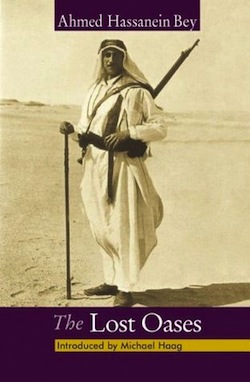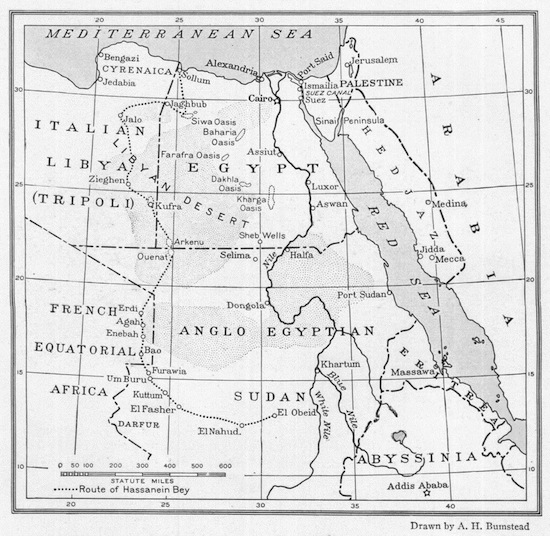Reading The Lost Oases by Ahmed Hassanein Bey
 I’ve always loved vintage travelogues. The world was bigger a hundred years ago, its cultures more distinct and isolated. Travel was hard and sometimes dangerous. Accounts of old journeys bring me back to a time when people could go to places like Africa and not be able to text home.
I’ve always loved vintage travelogues. The world was bigger a hundred years ago, its cultures more distinct and isolated. Travel was hard and sometimes dangerous. Accounts of old journeys bring me back to a time when people could go to places like Africa and not be able to text home.
But there’s always been a problem with the genre. The vast majority of the books available in English are from the Western perspective, especially the Anglo perspective. So The Lost Oases, written by Egyptian Ahmed Hassanein Bey and published in 1925, came as a welcome change. It’s an Arab account of discovering two remote oases in the far southwest of Egypt, hundreds of miles from the nearest habitation.
Ahmed Hassanein Bey was a wealthy Egyptian of Bedouin stock who was educated at Oxford, so he is good at explaining his own culture to the Western reader and yet remains enough of an outsider that we can enjoy watching his learning curve as he visits his country cousins.
He was already an experienced desert traveler when he set out on this mission, and we’re carried through a detailed description of his preparations and planning. When all is ready, he goes to his father for a moving scene where the old man blesses him and the baggage for a safe journey.
After skirting the coastline, the caravan heads south along the Egyptian/Libyan border. At this point in history, Egypt was administered by the British Empire and Libya by Italy. The main group along the border, then and now, is called the Senussi. I mainly knew of them from their attempt to invade Egypt during the First World War at the urging of the Germans and Ottomans.
The author goes into some detail about this important sect, which started as a Islamist reform movement in the mid-nineteenth century. The tribes of Libya had apparently lost their way. One tribe had set up a fake Kaaba, saying you didn’t need to go to Mecca anymore. Another tribe would go to a valley in the desert at the beginning of Ramadan and shout out, “Do we need to fast this year, yes or no?” When the echo came back saying “No, no, no,” that was good enough for them.

A map of the expedition
The Senussi movement got rid of all that with remarkably little bloodshed, instead spreading preachers and setting up schools in every large settlement to convince the people through superior erudition. Being Sufi, they also didn’t descend into fanaticism. Some of the most interesting passages of the book are the author’s time visiting with this group.
As the caravan moves south, things begin to get tougher. Wells get further and further apart, and are often filled in with sand, requiring a hard bit of digging in the hot sun before the thirsty Bedouin can get down to the water. There’s time for fun, too. When they come across a pretty Bedouin lass in some remote oasis or encampment, they’ll “empty powder” on her. This involves galloping toward the girl on your camel, stopping right in front of her, and firing your gun as close to her feet as possible. The point is to leave a powder burn on her slippers, which she’ll show off to everyone as a mark of pride.
I don’t suggest you try this with that attractive woman you’ve been eyeing at the gym. Your intent might get lost in translation.
There are a couple of tense moments when the caravan’s guide loses his way, and some grim descriptions of the fate that befell unlucky caravans in the past, but in fact there is very little danger in this travelogue. Instead it’s the beauty of the desert and the fascinating account of a now-vanished way of life that carries the narrative forward. I highly recommend this to anyone who loves travel literature or is interested in desert life.
Sean McLachlan is the author of the historical fantasy novel A Fine Likeness, set in Civil War Missouri, and several other titles. Find out more about him on his blog and Amazon author’s page. His latest book, The Case of the Purloined Pyramid, is a neo-pulp detective novel set in Cairo in 1919.
I was wikipedia article jumping a couple months ago and ended up reading the whole page on the Siwa Oasis. Interesting stuff.
You’re better read than I, Glenn!
Sean, have you read anything by Stephen Graham? He was quite the foot-traveller. Algernon Blackwood loved his early book A Vagrant in the Caucasus. I’ve got that one on hand (also A Tramp’s Sketches). I’ve read Undiscovered Russia and With the Russian Pilgrims to Jerusalem.
Here’s Blackwood’s enthusiastic blurb:
https://books.google.com/books?id=UW1BAAAAIAAJ&pg=PA340&lpg=PA340&dq=%22stephen+graham%22+%22algernon+blackwood%22&source=bl&ots=l5p3Sb-eSF&sig=0zduWufMVzqpN1DtCadAZMuNwEQ&hl=en&sa=X&ved=0ahUKEwi45I2YvabZAhUrja0KHbzVDzwQ6AEIOjAD#v=onepage&q=%22stephen%20graham%22%20%22algernon%20blackwood%22&f=false
Glenn: I might be going to Siwa Oasis later this year. Watch this space!
Major: His Gentle Art of Tramping is a beautiful book. Highly reccommended.